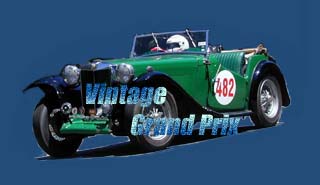
Pittsburgh Vintage Grand Prix is one of the best of its kind in the country. A very different kind of race than the marathon, it requires different kinds of communication. The course is entirely located within Schenley Park so that the amateurs can communicate station to net control directly; and vice versa; repeaters are not needed. The 2 mile course is divided into 20 positions, located at curves and corners so that no portion of the track is unobserved. A radio ham is assigned to each positon. There are Corner Captains and workers, all skilled in auto racing rules and signals.
The Corner Captains communicate with the drivers by the use of colored flags. The workers communicate with the Captains with hand signals. And the radio amateurs relay the Captain's information to the net control, and any necessary information back to the captain. It is through these communications that the race track is kept safe, by alerting all to any hazard.
Flag communication:
-
 solid yellow -- Caution, no passing. Shown for first lap of race solid yellow -- Caution, no passing. Shown for first lap of race
-
 yellow and red stripe - slippery, proceed with caution yellow and red stripe - slippery, proceed with caution
-
 blue with diagonal yellow stripe - faster car approaching blue with diagonal yellow stripe - faster car approaching
-
 orange circle on black background - "meatball" mechanical problem, stop at pit orange circle on black background - "meatball" mechanical problem, stop at pit
-
 solid red - stop now solid red - stop now
-
 solid white - emergency vehicle on course solid white - emergency vehicle on course
-
 Checkered flag - end of race Checkered flag - end of race
Lets give an example of how this all works. A worker spots fluid leaking from under one of the sports cars. He gets the Captain's attention with a whistle, and signals the car number and the fact that it is leaking fluid through hand signals. The radio amateur sends this information to net control, who broadcasts for all corners and stations to watch as the car in question passes. If the fluid is gas or water, which evaporates, that information is passed on and that is the end of it. But if it is oil, and remains on the road, for the remainder of the race that corner will have a caution flag - a red and yellow striped flag - displayed. At the end of the race, the workers will attack the oil spill with kitty litter and brooms.
A more serious example. Smoke is reported billowing from one of the cars, and net control wants to get that car off the track. Two stations - at the start line and at the half way mark - have number boards on which they display the number of the car and wave the meatball - a red disk on a black background - flag. The smoking car sees the warning and pulls off at the nearest pull-off point.

The Corner workers, dressed in white, include the Corner Captain and a team of workers who are spaced down the course to scan the road and cars during the race, and to clean up afterwards. The radio hams are considered part of this team.
During the races, there is an emergency vehicle at each major corner, with a team of medical workers and a team of firemen. Along the course there are several tow trucks and a flat bed truck, in case of breakdown or accident.
Jersey barriers are placed to delineate the race course, and all hazards (hydrants, trees, jersey barriers, even storm grates) are protected by bales of hay. These have to be placed well before the race and moved afterwards. Porta-potties, for the benefit of spectators and workers, and snow fencing to keep bystanders off the course are also the responsibility of the park department.
The cars, which are in the park overnight the weekend of the race, must be protected from vandalism, and several of the area motorcycle clubs volunteer for that duty. All volunteers are fed both lunch and dinner on the two days of the race, and the food tents are manned by still more volunteers. When you think about it, it takes an army of workers to make the Grand Prix run!
|


 solid yellow -- Caution, no passing. Shown for first lap of race
solid yellow -- Caution, no passing. Shown for first lap of race  yellow and red stripe - slippery, proceed with caution
yellow and red stripe - slippery, proceed with caution  blue with diagonal yellow stripe - faster car approaching
blue with diagonal yellow stripe - faster car approaching  orange circle on black background - "meatball" mechanical problem, stop at pit
orange circle on black background - "meatball" mechanical problem, stop at pit solid red - stop now
solid red - stop now  solid white - emergency vehicle on course
solid white - emergency vehicle on course  Checkered flag - end of race
Checkered flag - end of race